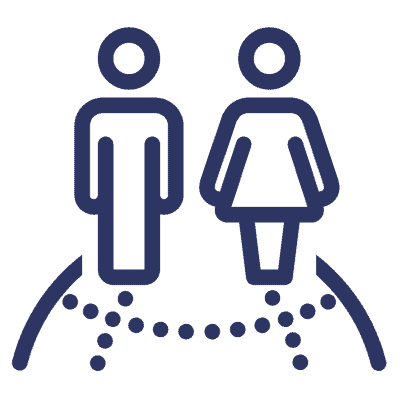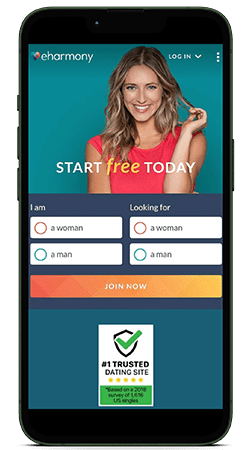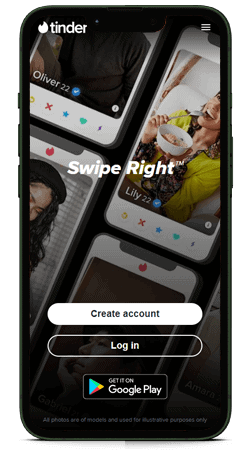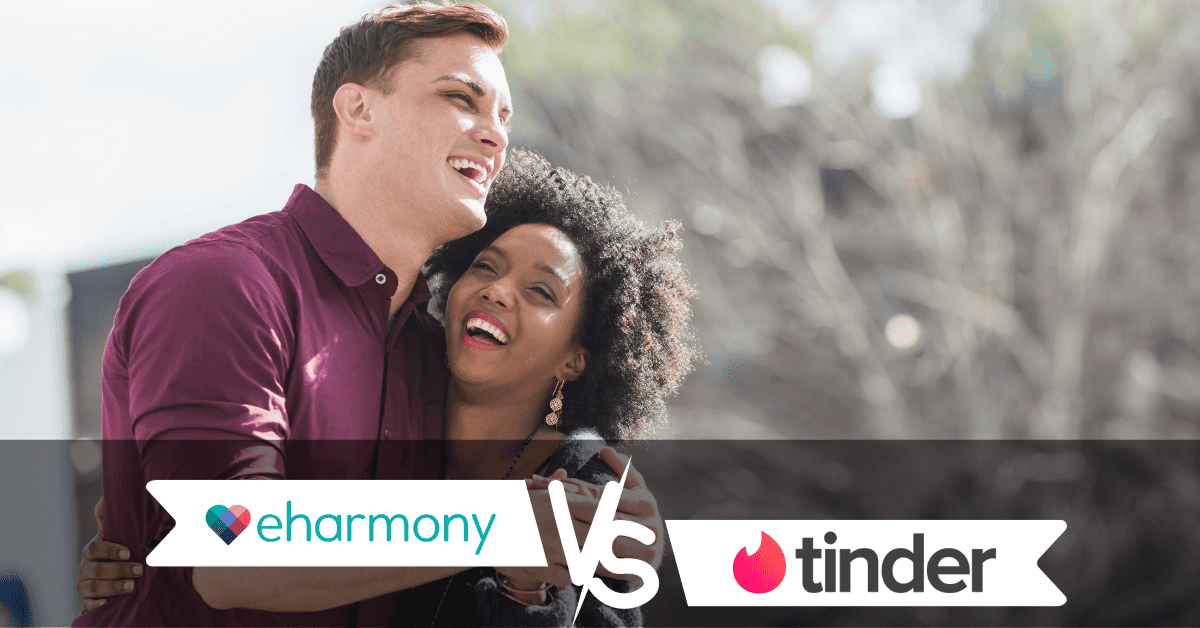How do you go about choosing the “right” dating app when there are SO many? It can be overwhelming! That’s where we come in! We are your pinch hitters when it comes to telling you everything you need to know about these online platforms. And today, we’re focusing on two of the biggest players on the field —eharmony and Tinder.
Even though you recognize the names, don’t mistake them for each other—not all dating apps are created equally, and these two offer pretty different dating experiences! eharmony is known for helping people find serious, long-term relationships. It asks users to fill out detailed questionnaires and then uses that info to match them with compatible partners. On the other end of the spectrum is Tinder, which is all about quick, casual connections. It lets users swipe through profiles at the speed of light to choose people they find hot or interesting, making the whole thing feel more relaxed.
eharmony is the place to be when you’re ready to settle down and find true love. It takes extra time and effort to create a profile because they want to understand who you really are and what you’re looking for. This way, the matches you get are more likely to be with people you’ll click with. Meanwhile, Tinder is more laid-back and open to different kinds of connections, whether you’re looking for something casual or a bit more serious. You just look at people’s photos and maybe read their bio to decide if you’re interested or not, making it quicker.
Each app has its own energy and attracts different kinds of users because of it. eharmony tends to draw in people who are looking for love and marriage, thanks to its reputation for creating long-term connections. Tinder, with its swiping function and less-detailed profiles, appeals to people looking for something a bit more casual, although it’s possible to find all kinds of relationships there. As we compare the apps, we’ll explore all odds and ends of eharmony and Tinder to help you figure out which one might be the right choice for your dating life!
Side to Side Comparison
When it comes to online dating, eharmony and Tinder stand out as two popular choices, each with its own approach to helping users connect. eharmony aims for depth and long-term relationships, while Tinder prioritizes ease of use and casual connections. Below, let’s look into some basic aspects of each platform to understand their basic differences.
| eharmony | Tinder | |
|---|---|---|
Focus | Serious, long-term relationships | Casual connections, though varied relationships, can be formed |
Matching Method-Up | Comprehensive personality questionnaire and sophisticated matching algorithm | Swiping through profiles based on photos and short bios |
User Demographic | Generally appeals to daters seeking stable, committed relationships | Broad user base, popular among younger adults |
User Experience | Detailed profiles, no swiping | Simplified profiles, swiping feature |
Reputation | Known for creating meaningful, lasting connections | Noted for casual dates and quick meet-ups, but also stories of longer-term relationships |
User Demographics

When we consider user demographics between eharmony and Tinder, the differences are quite clear and stem largely from their distinct approaches to online dating. eharmony tends to attract individuals who are more settled in life and are actively seeking long-term relationships or marriage. On the flip side, Tinder appeals to a wider, often younger demographic who enjoy its casual, fast-paced approach to dating, which doesn’t necessarily prioritize long-term connections.
- eharmony:
- Age Range: Skews towards an older demographic, commonly 30s and above.
- Relationship Goal: Users typically seek serious, long-term relationships or marriage.
- User Base: Known for a somewhat balanced gender ratio with a slight female predominance.
- Geography: Popular in countries seeking committed relationships, such as the United States, Canada, and the United Kingdom.
- Tinder:
- Age Range: Popular among a younger demographic, notably between 18-29.
- Relationship Goal: Famed for casual dating and dubbed “the hookup app,” though all relationship types can be found.
- User Base: Boasts a large and diverse user base, with millions of users worldwide.
- Geography: Widely used globally, especially in urban areas and among young adults in countries across continents.
User Interface and Experience

Dating app users heavily rely on user interfaces and experiences that they offer. eharmony provides a detailed and structured interface aimed at comprehensive profile creation and thorough match-finding. In contrast, Tinder offers a straightforward, visually driven interface that emphasizes user photos and quick decision-making.
- eharmony:
- Profile Creation: Detailed, requiring answers to extensive questions.
- Matching Mechanism: Provides matches based on compatibility scores from user responses.
- Interface: Structured and informative, emphasizing user information and compatibility.
- Communication: Enables messaging upon mutual interest, with guided communication options.
- Tinder:
- Profile Creation: Simple and quick, emphasizing user photos with a short bio option.
- Matching Mechanism: Utilizes swiping – swipe right to like and left to reject.
- Interface: Visual and straightforward, focusing on quick browsing of user photos.
- Communication: Allows messaging when both users have swiped right, indicating mutual interest.
Features

eharmony and Tinder each have their own set of tools or “features” to help users in the dating game, but they work in pretty different ways. eharmony has a lot of features that help users get to know potential matches’ personalities and likes or dislikes. Tinder keeps things light and easy, offering features that let users make quick choices based on first impressions—sometimes superficial ones.
- eharmony:
- Compatibility Quiz: Lengthy questionnaire designed to understand user personality and preferences.
- Guided Communication: Offers prompts and pre-written messages to facilitate conversation.
- Video Date: Enables users to have virtual dates directly through the platform.
- Match Preferences: Allows users to set criteria for potential matches, including age and distance.
- Tinder:
- Swipe Feature: Users swipe right to like a profile and left to reject.
- Super Like: An option to signal heightened interest in another user.
- Boost: A feature that promotes user profiles to gain more visibility.
- Tinder Passport: Allows users to connect with others in different geographical locations.
Pricing

Choosing between eharmony and Tinder also means looking at how much they cost. eharmony is way pricier because it offers detailed ways to find serious relationships. Tinder is more wallet-friendly and is easy to use, making it popular for quick, casual connections. Both of them have different premium plans and perks that can change your experience and the price you pay!
- eharmony:
- Free Version: Limited features but includes the personality test and viewing of profiles.
- Premium Light: The six-month plan ($65.90 per month) includes unlimited messaging and viewing of all photos.
- Premium Plus: 12-month plan ($45.90 per month) with extra features such as detailed personality analysis.
- Premium EXTRA: 24-month plan ($35.90 per month) offering the most savings and all available features.
- Tinder:
- Free Membership: Allows profile creation, basic swiping with a limited number of right swipes per day, and messaging with matched profiles.
- Tinder Plus: Pricing ranges from $4.50 to $13.49 monthly, and discounts are available for longer commitments. Benefits: Unlimited likes, rewinds on swipes, 5 Super Likes a day, 1 free Boost per month, and a Passport feature to swipe anywhere in the world.
- Tinder Gold (An enhanced premium tier): Pricing is above Tinder Plus, ranging from $7.50 to $22.49 monthly, with discounts for longer term commitments.Benefits: All features of Tinder Plus, plus the ability to see who liked you before you swipe and access to curated Top Picks.

Background and History: eharmony vs Tinder
eharmony and Tinder were created with wildly different intentions and attracted varied users as a result. eharmony, launched in 2000, was designed to help people find long-term relationships using detailed personality tests. Contrastingly, introduced in 2012, Tinder aims to make connecting with new people fun and easy through its groundbreaking swiping feature. While both have forged their own paths in online dating, they cater to the diverse needs and experiences of daters everywhere.

eharmony
- Founded: 2000
- Founder: Dr. Neil Clark Warren
- Initial Purpose: To help individuals find long-term, committed relationships through scientifically based matching.
- Unique Feature: An extensive personality test to help find compatible matches.
- Demographic: Generally targeted towards those looking for serious relationships.

Tinder
- Founded: 2012
- Founders: Sean Rad, Justin Mateen, Jonathan Badeen, Joe Munoz, Dinesh Moorjani, and Whitney Wolfe Herd (she went on to found the Bumble dating app).
- Initial Purpose: To simplify the process of meeting new people, initially with a focus on more casual relationships.
- Unique Feature: Swipe right to like a profile, and swipe left to pass.
- Demographic: Widely used by younger individuals and often associated with casual dating.
Free Trial Comparisons: eharmony vs Tinder
Free trials are a perfect way to try out dating apps like eharmony and Tinder without committing any cash for the experience. Both platforms provide some version of a free trial or a free version with limited features, letting users get a taste before deciding on a full, paid experience. Let’s see what each app offers in the way of free services!

eharmony Free Trial
- Basic Plan: Allows users to create a profile and view limited matches.
- Communication: May offer occasional free communication weekends.
- Profile Views: Users can see who viewed their profile but can’t view their photos.

Tinder Free Trial
- Free Version: Allows swiping, matching, and messaging with other free users upon a mutual match.
- Daily Likes: Limited to a certain number of likes per day.
- Geographic Limits: Users can only swipe in their current location.
Success Rates: eharmony vs Tinder
When picking a dating app like eharmony or Tinder, people often want to know: does it actually work? Both apps say they’ve helped people connect, but they do it in different ways and for different kinds of relationships. Let’s break down some of the success each one talks about.

eharmony
- Claimed Successes: Often cites that it is responsible for a significant number of marriages in the U.S.
- Focus on Long-Term: Primarily attributes its success to its compatibility-focused approach.
- User Testimonials: Features numerous stories of couples who found lasting love through the platform on a dedicated section on its website.

Tinder
- Global Connections: Boasts numerous matches made globally since its inception.
- Diverse Relationships: Success stories vary from casual dates to enduring partnerships.
- User Testimonials: Offers a variety of stories about connections made on the platform, from friendships to marriages.
Signing Up: eharmony vs Tinder
Registration, setting up an account, and building a dating profile on eharmony and Tinder are different—each has its own way of bringing new users onboard. eharmony has a much more comprehensive setup so they can get to know you better right from the jump, while Tinder keeps things light and easy—you can just plug in basic details and go. Below is what the sign-up process entails on each platform.

eharmony
- In-Depth Questionnaire: Extensive questions to understand personality and preferences.
- Profile Creation: Detailed profiles to showcase personality, lifestyle, and preferences.
- Verification: Email verification is required to ensure genuine sign-ups.

Tinder
- Quick Setup: Minimal info needed for profile setup.
- Profile Info: Brief details and photos can be easily uploaded, often linked to social media.
- Verification: Optional phone and photo verification are available for added security.
Dedicated Mobile Apps: eharmony vs Tinder
eharmony and Tinder both have dedicated mobile apps that allow people to try to find their match no matter where they may be, whether it’s a plane, train, or automobile. eharmony’s app is all about detailed profiles and getting to know someone more intimately, while Tinder is all about brevity with quick looks and chats. They each bring their own style to supporting people who connect on their smartphones or devices—here’s a breakdown of how each mobile app does its thing.

eharmony
- Intuitive Design: Aesthetically pleasing and easy-to-navigate design with clear menus and actions.
- Compatibility Test: Users can delve into the meticulous compatibility questionnaire, creating a thorough profile directly in the app.
- Strong Communication: Beyond just messages, the app facilitates likes, winks, and pre-defined icebreaker questions to nudge potential connections.
- Notification Settings: Customizable to ensure users stay informed on match activity without being overwhelmed.
- Compatibility: Functionally seamless and available for download on devices operating iOS and Android.

Tinder
- Streamlined Interface: Predominantly visual, enabling users to make quick decisions based on initial impressions, primarily through swiping.
- Geolocation Features: Utilizes user location to recommend matches nearby, increasing the likelihood of in-person meetups.
- Interactive Messaging: Not just confined to texts, the messaging feature also allows sharing gifs, links, and more to make conversations more fun.
- Social Media Integration: Offers the option to link Instagram and Spotify, offering a wider lens into users’ social and personal interests.
- Compatibility: Designed to be user-friendly on various mobile devices, being compatible with both iOS and Android operating systems.

What’s eharmony Best For?
eharmony has solidified its standing in the online dating world as a go-to for serious relationship-seekers by prioritizing genuine, long-term connections. It’s particularly suited for those who are actively seeking committed relationships and even marriage. Here’s a snapshot of what eharmony is best known for:
- Genuine Connections: Encourages creating deep connections based on personality and lifestyle compatibility.
- Serious Relationships: Made for people looking for serious, committed relationships.
- In-depth Profiles: Comprehensive profiles help in understanding the depth of a person beyond just pictures.
- Compatibility-Focused: Uses a scientific approach to match users based on compatibility scores from extensive questionnaires.
- Guided Communication: Offers structured communication options to ease users into meaningful conversations.
- Safety Measures: Provides features like video dating and secure call options to enhance user safety.

What’s Tinder Best For?
Tinder, with its iconic swipe feature, has revolutionized the digital dating landscape, enabling users to connect with others in a fun, casual, and fast-paced environment. It’s particularly favored among younger audiences and those interested in varied types of relationships. Here’s what Tinder is typically best for:
- Casual Connections: Widely recognized for facilitating more casual, short-term relationships or hookups.
- Quick Browsing: Enables users to quickly browse through profiles with minimal information to make swift decisions.
- Simple Interface: Known for its straightforward and easy-to-use interface—there’s minimal effort to get started.
- Global Reach: Offers a large, global user base, providing vast options and diverse potential matches.
- Inclusive: Welcomes all types of relationships and orientations, providing a broad platform for various connections.
- Social & Fun Features: Like “Swipe Night” events and in-app activities that provide a fun and engaging user experience.
Takeaways
To tie this all into a near little bow, eharmony and Tinder indulge different daters’ needs and wants when it comes to romantic connections. eharmony goes super deep, attempting to connect people looking for serious, lasting relationships by using detailed profiles and science-based compatibility scores.
With its easy swiping and less-detailed dating profiles, Tinder gives users a much more casual and quick dating experience, which means it’s chosen by a younger and diverse crowd. The choice between the two ultimately hinges on your personal dating goals and endgames and how you approach online dating!




